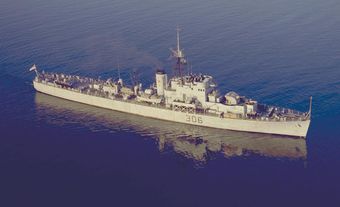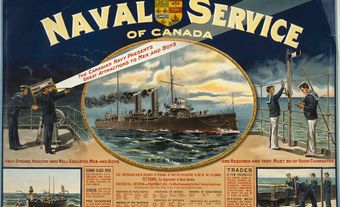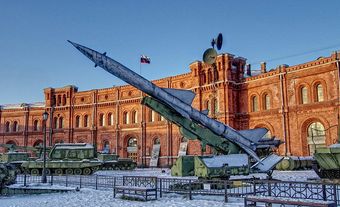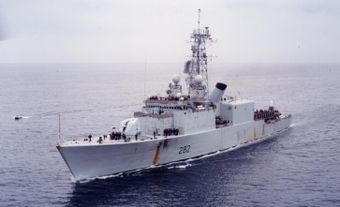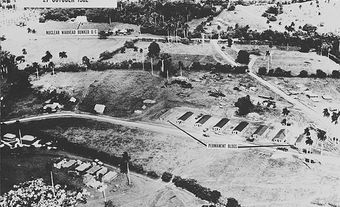The St Laurents were developed in the early Cold War as a high-speed, long-range antisubmarine frigate to counter the growing Soviet conventional submarine threat. They were the first major warship class designed and built in Canada and incorporated many ground-breaking features, earning them the nickname, the “Cadillacs.” Seven St. Laurents were built. The success of the design inspired a succession of follow-on classes: the Restigouche, Mackenzie and Annapolis classes. A total of 20 ships — all named after Canadian rivers — were built around the same hull configuration and propulsion plant. These iconic ships were the mainstay of the Canadian fleet from 1955 to 1995, including most of the Cold War.

St Laurent Class
In 1947, the Royal Canadian Navy (RCN) noted the Soviet Navy was adapting advanced German U-boat technology into their rapidly expanding submarine fleet. The navy realized that antisubmarine warfare (ASW) would remain a major concern and concluded that “The escort of the future does not yet exist.” Neither the American nor the British navy had a suitable antisubmarine (AS) frigate for purchase, nor did they have any immediate plans to build one, so in July 1948 the RCN established its own warship design authority.
Within months, the RCN had produced a preliminary sketch of a revolutionary flush-decked vessel. The design was endorsed by the Naval Board on 19 January 1949. Prime Minister Louis St Laurent’s Cabinet approved construction of an initial three ships on 26 March, a week before the first meeting of the NATO Council on 5 April. Four more were authorized in August 1950, following the outbreak of the Korean War. In the meantime, as detailed design work progressed, the Naval Board realized this was a whole new class of ship: more capable than the Second World War AS frigates, but not as large as a general-purpose postwar destroyer. Thus, the Naval Board re-styled them “destroyer escorts” (DDE). The lead ship of the class was designated HMCS St Laurent after the French spelling of the St. Lawrence River; it was also the name of a Second World War destroyer, not to mention that of the prime minister who approved their building. The ship was laid down on 24 November 1950, launched two years later, and commissioned on 29 October 1955.
Design
Although the ship’s preliminary design was produced by the navy, detailed design work was contracted in June 1949 to the Montreal naval architect firm German and Milne. One of the ship’s key features was the innovative Y-100 propulsion plant, a 30,000-shaft horsepower twin-boiler geared turbine that took up much less interior space than other technologies while providing a top speed in excess of 28 knots (52 km/hr), and a range of 4,500 nautical miles (8,400 km) at 12 knots (22 km/hr). Twin screws and rudders made for exceptional manoeuvrability.
The St Laurent’s flush deck ran the length of the ship, making this the first class of small warship in which the crew could travel from bow to stern without going onto the upper deck. Other crew conveniences new to the RCN included individual bunks (instead of hammocks) with reading lamps, larger personal lockers, cafeteria messing (instead of “broadside” bucket delivery of meals to messdecks), improved “heads” (toilets) and washrooms, better lighting, more refrigeration and freezer space, good supplies of fresh water, and air conditioning. Another radical concept was to enclose the bridge (previously open to the elements) and create a large operations room a deck below from which the captain would “fight” the ship rather than conning (controlling) it from the bridge.
The rounded hull and deck edges were designed to reduce ice buildup and to shed radioactive, chemical and biological (NBC) residue more easily in case of an attack. Upper deck machinery was minimized to counter the buildup of ice; for example, the anchors were handled below the fo’c’sle deck and stowed behind heated “anchor pocket doors.”
As much of the ship’s equipment and many of its facilities were located below deck, the crew could also operate the ship more safely in an NBC fallout area. A “pre-wetting” spray system washed off any contamination and most interior spaces were over-pressurized. This meant that much of the crew could live and operate in a “citadel” sealed off from the outside environment.
Armament
The main armament was a pair of 3-inch radar-guided twin gun mounts for protection against air and limited surface attack, one each forward and aft, two 40mm anti-aircraft guns (although these were soon discarded), two single torpedo launchers and two of the latest antisubmarine mortars, the triple-barrelled British Limbo Mk.NC 10. These mortars could be directed by sonar fire control systems from the operations room and fired in any direction, unlike depth charges that were rolled off the stern or earlier mortars that could only fire ahead.
Construction
Construction was distributed amongst seven shipyards: five on the east coast (in Montreal, Sorel and Lauzon, Quebec; and Halifax, Nova Scotia); and two on the west (in Vancouver and Victoria, British Columbia). None could be built on the Great Lakes as the expansion of the St Lawrence Seaway was only then in progress. Other than the boilers and mortars, all systems were built to North American standards for ease of construction and repair. The navy also planned to quickly build additional ships in case of emergency. Hull sections could be prefabricated as units that could be transported by rail and assembled at shipyards.

Follow-on Classes and Conversions
Although the navy originally planned to build 14 St Laurent-class destroyer escorts, only seven were built: St Laurent, Assiniboine, Ottawa, Saguenay, Skeena, Fraser and Margaree. Improvements in ASW technology developed during construction and the remaining seven ships were laid down as the Restigouche class: Restigouche, St Croix, Gatineau, Kootenay, Terra Nova, Columbia and Chaudière. The Restigouches had a longer, higher-powered 3-inch forward gun, which meant the enclosed bridge had to be raised and enlarged. A further four ships of similar configuration were approved in 1958 and designated the Mackenzie class: Mackenzie, Saskatchewan, Yukon and Qu’Appelle.
As the Restigouches and Mackenzies were being built, the RCN was experimenting with two separate concepts that would fundamentally alter the approach to shipboard ASW: variable depth sonar (VDS) and carrying a helicopter on board. Both concepts proved immensely successful, and all seven of the original St Laurents underwent a major reconstruction from 1962 to 1964. This entailed adding a hangar and landing deck behind the funnels, while removing one set of the Limbo mortars to make way for a VDS. The rebuilt St. Laurents had a new and distinctive hull form and were reclassified as the helicopter-carrying destroyer (DDH). The St Laurent DDH pairing with the CH-124 Sea King helicopter became emblematic of the Canadian naval Cold War experience.

The final version of the St Laurent design was the two-ship Annapolis class, which was built from the keel up as helicopter-carrying ships in the 1960s. The Annapolis and Nipigon were the last of the hull-form, for a total of 20 ships. A follow-on class was proposed soon after as “Repeat Nipigons” to incorporate yet more improvements in ASW equipment. The decision to change the steam propulsion in favour of new gas turbine technology, and the fitting of self-defence Sea Sparrow missiles however, resulted in an entirely new design that became the Iroquois-class destroyer (DDH-280).
Between 1968 and 1972, four of the seven Restigouches (Terra Nova, Gatineau, Kootenay and Restigouche) were converted to Improved Restigouche Escort (IRE) standard, exchanging the aft gun and one of the Limbo mortar mounts for an ASROC launcher (a rocket-thrown ASW torpedo) and a VDS. A distinctive lattice mast to host a variety of new radar equipment made for a distinctive visual profile. The other three ships of the class were put into reserve status and used for non-sea-going purposes.

Did you know?
On the morning of 23 October 1969, HMCS Kootenay was part of a task force returning to Canada after exercises in British waters when the ship was ordered to carry out a routine full-power trial. An explosion happened shortly afterward, the result of an improperly installed gearbox bearing. In the explosion and the fire that followed, 9 crew members were killed and 53 others injured. It was the worst peacetime disaster in the RCN’s history. Many safety features were learned from the incident and quickly fitted throughout the fleet. (See HMCS Kootenay Disaster.)
Several ships of the St Laurent, Restigouche and Annapolis classes received further modifications as the Cold War continued. This included upgrades of combat sensors and machinery systems in the 1980s, while a replacement class was being built (the Halifax-class frigates, the first of which was commissioned in 1992). Fraser, Annapolis and Nipigon also had their VDS replaced with the early models of the passive sonar Canadian Towed Array System (CANTASS), which would be the primary ASW sensor of the Halifax-class frigates.
Service
The original St Laurents and the Restigouches spent much of their early service divided between the coasts on which they were built.
Following unification of the armed forces in 1968, the fleet was redistributed. The more capable DDHs (the original seven St Laurents and the two Annapolis class) were based in Halifax to be available for NATO operations, while the west coast kept the improved Restigouche escorts for operations and the Mackenzie class became the backbone of a training squadron.
Since the Cold War never turned “hot”, other than the Cuban Missile Crisis, the only ship of the general type to see action was Terra Nova in the Persian Gulf War of 1990–91. The hasty upgrades required for this effort saw the IRE’s ASROC launcher and Limbo mortar replaced respectively with a pair of Harpoon antiship missile launchers and an antimissile Phalanx CIWS (Close-in Weapons System). Restigouche was similarly modified but never saw action.

Decommissioning
St Laurent was sold for scrap in 1974 but foundered under tow in a gale off Cape Hatteras. Most of the others saw out the Cold War but were progressively removed from service as they were replaced by the Halifax class through the 1990s. Seven of them became artificial reefs for diving enthusiasts.
The last of the general type to leave service was Nipigon on 1 July 1998, which remains as a diving reef off Rimouski, Quebec. Controversially, the last of the type to be disposed of was HMCS Fraser. The ship was paid off on 5 October 1994 and sold four years later. It was supposed to become a floating museum in Bridgewater, Nova Scotia, but the plan fell through, and it deteriorated badly. Fraser was broken up for scrap in 2011.

 Share on Facebook
Share on Facebook Share on X
Share on X Share by Email
Share by Email Share on Google Classroom
Share on Google Classroom

